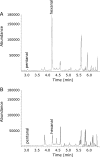Quantification of hexanal as an index of lipid oxidation in human milk and association with antioxidant components
- PMID: 22128211
- PMCID: PMC3208008
- DOI: 10.3164/jcbn.10-142
Quantification of hexanal as an index of lipid oxidation in human milk and association with antioxidant components
Abstract
Hexanal, a secondary product of lipid oxidation, was identified as the major volatile aldehyde generated from lipid peroxidation in human milk. Hexanal was quantified in human milk using solid phase microextraction-gas chromatography/flame ionization detection that required correction for recovery based on the fat content of human milk. Alpha-tocopherol was the only tocopherol isomer in human milk found to be significantly correlated with hexanal (R = -0.374, p<0.05) and the total antioxidant capacity of human milk (ORAC(Fl) (R = 0.408, p<0.01)). Ascorbic acid content was negatively correlated (R = -0.403, p<0.05) with hexanal, but not to ORAC(Fl) in human milk. The effect of Holder pasteurization on oxidative status of human milk was determined using multiple parameters that included, hexanal level and malondialdehyde as markers of lipid oxidation, vitamins C and E content and antioxidant capacity (e.g. ORAC(Fl)). Pasteurization did not affect the oxidative status of milk as measured by hexanal level, ORAC(Fl) and malondialdehyde content. We conclude that hexanal is a sensitive and useful chemical indicator for assessing peroxidation reactions in human milk and that alpha tocopherol and ascorbic acid are two key antioxidant components in milk that contribute to protection against oxidation of milk lipids.
Keywords: SPME; antioxidant capacity; hexanal; human milk; pasteurization.
Figures






Similar articles
-
Does vitamin fortification affect light oxidation in fluid skim milk?J Dairy Sci. 2019 Jun;102(6):4877-4890. doi: 10.3168/jds.2018-15594. Epub 2019 Mar 21. J Dairy Sci. 2019. PMID: 30904314
-
Differences in vitamin E and C profile between infant formula and human milk and relative susceptibility to lipid oxidation.Int J Vitam Nutr Res. 2013;83(5):311-9. doi: 10.1024/0300-9831/a000173. Int J Vitam Nutr Res. 2013. PMID: 25305226
-
Development of a headspace solid-phase microextraction gas chromatography mass spectrometry method for the quantification of volatiles associated with lipid oxidation in whole milk powder using response surface methodology.Food Chem. 2019 Sep 15;292:75-80. doi: 10.1016/j.foodchem.2019.04.027. Epub 2019 Apr 6. Food Chem. 2019. PMID: 31054695
-
ELISA for monitoring lipid oxidation in chicken myofibrils through quantification of hexanal-protein adducts.J Agric Food Chem. 2003 Dec 17;51(26):7533-9. doi: 10.1021/jf034553f. J Agric Food Chem. 2003. PMID: 14664503
-
Solid phase microextraction-gas chromatography for quantifying headspace hexanal above freeze-dried chicken myofibrils.J Agric Food Chem. 2003 Jul 16;51(15):4185-90. doi: 10.1021/jf0260646. J Agric Food Chem. 2003. PMID: 12848482
Cited by
-
EFFECT OF PASTEURIZATION ON THE ANTIOXIDANT AND OXIDANT PROPERTIES OF HUMAN MILK.Rev Paul Pediatr. 2021;39:e2019165. doi: 10.1590/1984-0462/2021/39/2019165. Epub 2020 Aug 10. Rev Paul Pediatr. 2021. PMID: 32785463 Free PMC article.
-
Human milk enriched with human milk lyophilisate for feeding very low birth weight preterm infants: A preclinical experimental study focusing on fatty acid profile.PLoS One. 2018 Sep 25;13(9):e0202794. doi: 10.1371/journal.pone.0202794. eCollection 2018. PLoS One. 2018. PMID: 30252854 Free PMC article.
-
New covalent modifications of phosphatidylethanolamine by alkanals: mass spectrometry based structural characterization and biological effects.J Mass Spectrom. 2014 Jul;49(7):557-69. doi: 10.1002/jms.3373. J Mass Spectrom. 2014. PMID: 25044840 Free PMC article.
-
The Role of Elderberry Hydrolate as a Therapeutic Agent in Palliative Care.Antioxidants (Basel). 2025 Feb 18;14(2):233. doi: 10.3390/antiox14020233. Antioxidants (Basel). 2025. PMID: 40002417 Free PMC article.
-
Volatile emission in dry seeds as a way to probe chemical reactions during initial asymptomatic deterioration.J Exp Bot. 2016 Mar;67(6):1783-93. doi: 10.1093/jxb/erv568. J Exp Bot. 2016. PMID: 26956506 Free PMC article.
References
-
- Shoji H, Koletzko B. Oxidative stress and antioxidant protection in the perinatal period. Curr Opin Clin Nutr Metab Care. 2007;10:324–328. - PubMed
-
- Saugstad OD. Oxygen toxicity in the neonatal period. Acta Paediatr Scand. 1990;79:881–892. - PubMed
-
- Tully DB, Jones F, Tully MR. Donor milk: what’s in it and what’s not. J Hum Lact. 2001;17:152–155. - PubMed

